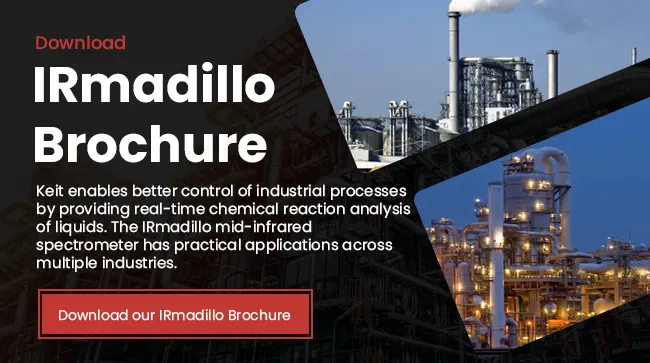The IRmadillo in the Distillation Process
Measuring the performance of the fuel ethanol distillation columns in real time allows the opportunity for constant process optimization - thereby minimizing energy consumption and maximizing ethanol recovery whilst ensuring product quality targets are met. In separate studies, the IRmadillo spectrometer has proved able to measure the relevant concentrations with levels of accuracy that allow true optimization of the process.

Introduction
Distillation is a vital step in the purification of ethanol following fermentation. The challenge for plant operators is to maximize ethanol product recovery and quality while minimizing the energy consumption of the distillation column. Operation of the columns needs to be optimized to both minimize ethanol losses in the whole stillage stream and minimize impurities such as acetal, methanol and longer chain alcohols in the ethanol product. This can only be done with continuous measurement of the whole stillage and column overhead compositions.
The IRmadillo is a process analyzer built using static-optics FTIR spectroscopy. Its solid-state design, with no moving parts or fiber probes, makes it stable, reliable and robust, and well-suited for production environments such as ethanol refineries. The IRmadillo provides detailed measurements of chemical concentrations in real time.
Safety benefits
One signficant benefit of continuous monitoring of the distillation column is the potential for safety improvements. Excessive alcohol in any waste stream is a cause for concern, and should be avoided wherever possible. The IRmadillo is an ideal instrument for ensuring that the operators are aware of what is going on in the plant, including what is going into the waste streams, so that they can react quickly. An additional safety benefit of online monitoring is to reduce the exposure of the operators to hazardous environments while collecting samples.

Figure 1
This application note presents data from an ethanol refinery in Iowa, measuring the concentration of ethanol and other components of the whole stillage, and also presents further lab data to demonstrate the ability of the IRmadillo to measure the concentration of acetal, methanol and pentanol in the column overheads.
Example use case - Whole Stillage
The IRmadillo was installed in the beer column bottom in order to measure the composition of the whole stillage. Models were built to measure Acetic Acid, Glucose, DP2, DP3 and DP4, Ethanol, Glycerol and Lactic Acid. The plant was able to observe in real time the concentrations of those species of interest at levels that allowed tighter control of the distillation column.

Table 1: Measurement accuracy for species of interest in distillation
.png?width=337&height=339&name=Figure%201%20all%20species%20distillation%20prediction%20(1).png)
Figure 2: Measurements of species of interest at the bottom of the distillation column. Grey points are the output of the IRmadillo spectrometer. The red points are the measured samples from offline HPLC

Figure 3: Tracking ethanol concentrations in the beer bottoms can be used to increase steam or direct the process liquid back to the beer column for reprocessing, maximizing ethanol yields.
Example use case – Distillation Overheads
Distillation separates chemicals using the property that different chemicals have different boiling points. The weakness of this approach is that chemicals with similar boiling points will tend to appear together in the finished distillate. This is the case with Acetal (BP 103°C), Methanol (BP 65°C) and Propanol (BP 97°C), which are sufficiently similar to Ethanol, which has a boiling point of 78°C. If the distillation column is operated incorrectly, such as at the wrong 'cut point', the ethanol may be contaminated with out-of-specification levels of contaminants.

Table 2: Measurement accuracy for species of interest in distillation overheads
Real-time measurement of these components make it easier to avoid this situation. Calibration models were therefore built on laboratory samples of ethanol with contaminant levels of Acetal, Methanol and Propanol. The IRmadillo was shown to be able to measure all three contaminants at low concentration levels, making it ideal for ethanol product quality control.
Conclusions
The IRmadillo is able to measure, in real time, key components of interest in whole stillage and ethanol overheads. By continuously monitoring both of these points using the IRmadillo, the operators would be able to manage the column to maximize product quality, while minimizing wastage and optimizing power consumption.

Figure 4
Keep in Mind
The IRmadillo can be calibrated to measure a large range of chemicals at the same time. This work shows the use for the IRmadillo in distillation but there are similar opportunities for improvement in fermentation, propagation and liquefaction measuring even more species such as FAN, PAN and fusels in real time.

